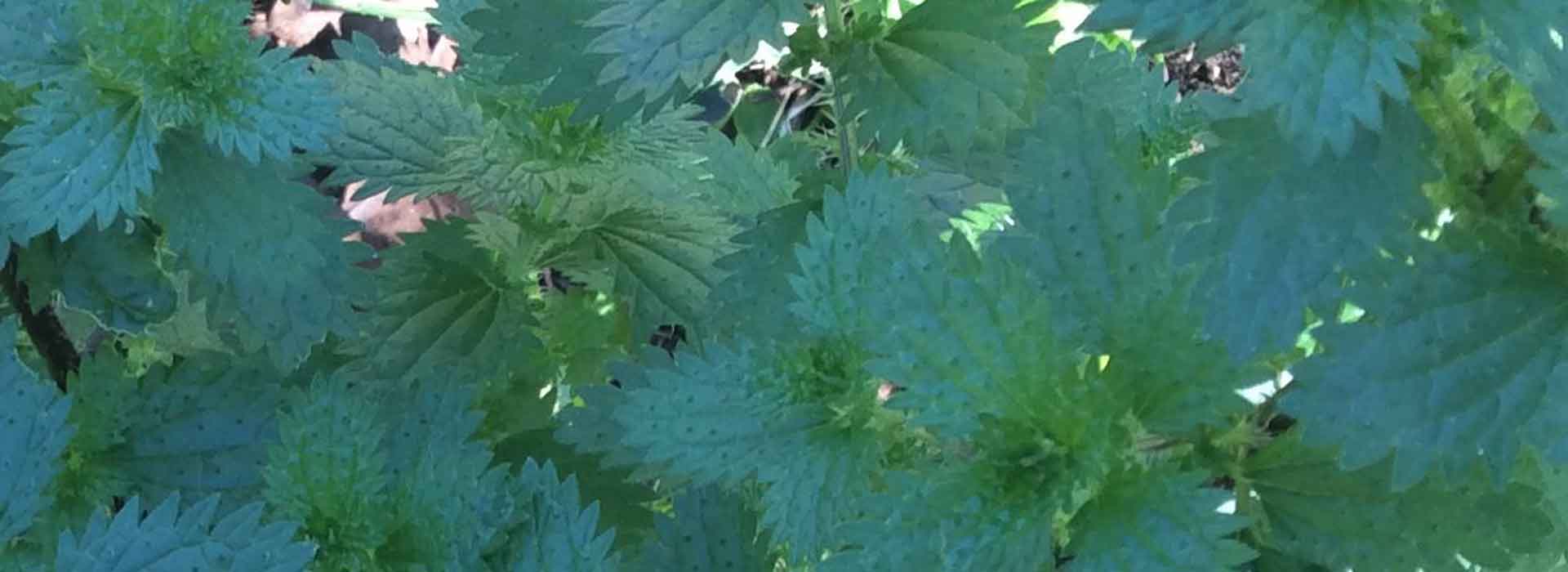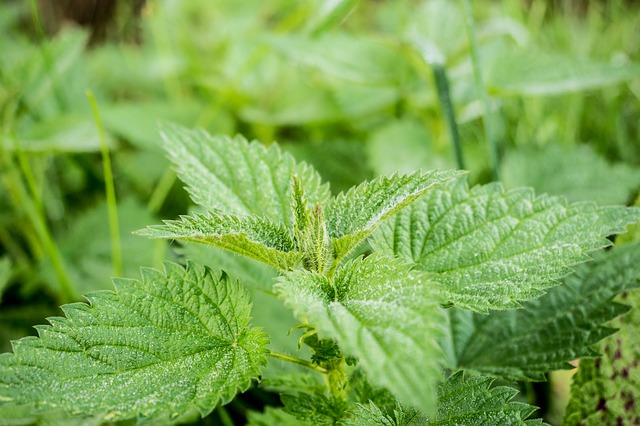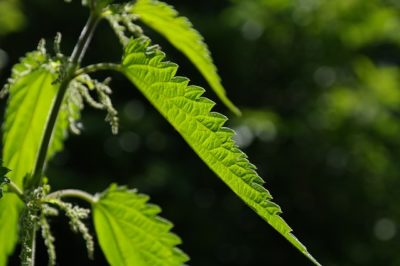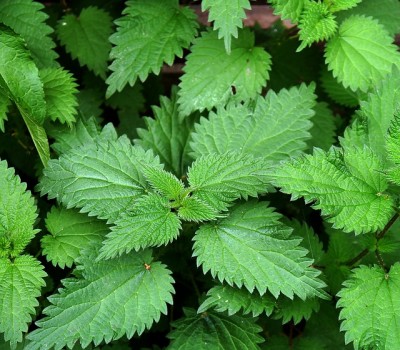Nettles - Friend or Foe
IN
EDIBLE GARDENING,
INVASIVE PLANTS,
VEGETABLES
|BY
SARAH MILLER
The hairy, dark green, finely toothed leaves are a real sign of winter. Although it is regarded as a weed by many and needs to be prevented from becoming invasive, I love this much maligned plant. It feeds the soil, plants, compost, hens and the humans in this household. It is an important component of my garden, and as Judith Collins says, it is valuable in any organic garden. This is because nettle is so nutritious, and beneficial to plant and human health.
Nettle is easily identified by the sting associated with its name, Stinging Nettle – and this sting is part of the reason why so few people grow and use it.
Urtica dioica,
U.urens and
U.incise are the three most common forms of stinging nettle. The sting comes from the fluid in the small barb like hairs growing on the face of the leaves and the stem. It is a painful sting but will usually go away after a few minutes. More instant relief can be given by rubbing the juice of the nettle plants itself on the affected part, but doing this may involve a few more stings. The most common remedy is the leaf of the dock plant- which naturally grows quite near the nettle. According to folk tales one should also say the following charm while rubbing the leaf slowly over the sting,
“Nettle in dock out
Dock rub nettle out” 1
This charm may have been a mnemonic helping us to remember which plant actually alleviated the pain!
While the botanical name of the plant Urtica derives from the Latin root,
uro – to burn, its common name nettle comes from the Anglo Saxon word
noedle, or needle, pertaining to its use as thread and cloth. Fibres from the nettle plant were a very common thread in Germany and Scandinavian countries up to the beginning of the last century. Nettle was used to make anything from clothes, linen, sails and even sheets. Nowadays we have forgotten many of the uses of this plant but only a few centuries ago, nettle was considered one of the most important fibres along with flax and hemp2. So those who like to experiment with eco-fashion could consider a nettle dress! Nettle can produce green and yellow dyes.
An Ideal Companion Plant
Nettle really is a phenomenal plant. Judith Collins author of the highly recommended, Companion Gardening in Australia (working with Mother Nature) lists stinging nettle as her favourite companion plant. She states “it improves the health of fruit trees and vegetables generally.” 3 It can be used as a companion plant in the vegetable garden, and is also an invaluable plant in the making of compost tea as it contains an abundance of iron, copper, phosphorous, and potassium.
Nettle tea for the garden
Fill ½- 3/4 of a large bucket with nettle leaves
Fill the rest of the bucket with water
Leave to stand for 1 week
Dilute 1 part nettle mix to 10 parts water
This nettle tea can be given readily to any of your plants. The benefit of nettle and other “compost teas” is that the vitamins and minerals are readily available to the plants. It feeds the soil while giving a really quick boost to plants since nutrients can be absorbed almost immediately.
Nettle tea is also recommended for you and me! It is a nourishing and nurturing tonic for the entire system4. With all the iron it contains, it is also a useful drink for menstruating women, and Susan Weed (yes that is her name) recommends nettle tea for all menopausal women. 5 So what are you waiting for, go and grab yourself a cup of nettle tea.
It really is a matter of gathering a large bunch of leaves and flowers (if present) using gloves of course. Place leaves in a plunger or pot and pour boiling water over and infuse for 5 minutes. Simple!
Nettle has quite a mild taste and can be mixed with other more aromatic leaves if you prefer. Given the goodness of the plant I also cook with nettles. One of my favourite recipes, Nettle and Buckwheat pancakes comes from the Stephanie Alexander Kitchen Garden Program at my children’s school, East Bentleigh Primary. This is an easy recipe you can make with the kids, and the pancakes are still delicious with maple syrup or any of your favourite pancake toppings but will be packed with the benefits of nettle including chlorophyll, proteins, Vitamins A, C and D, and of course all the minerals already mentioned above.
Nettle and Buckwheat Pancakes
1-1.5 cups of nettle leaves
I cup plain flour (can substitute gluten free flour)
6 tablespoons of buckwheat flour
1 tsp salt
3 eggs
3 cups milk
60 g butter melted and cooled
Half fill a saucepan with lightly salted water and bring to the boil.
Using tongs – drop in nettle leaves and swish for a minute
Drain nettles , and squeeze out excess moisture
Chop roughly
Sift flours and salt into a bowl
Lightly whisk together egg, milk and 40 g of butter
Make a well in the centre and tip in milk mixture
Using a whisk mix mixture together to form a batter
Stir in chopped nettle and leave to stand for 20 minutes
Heat a crepe pan over medium heat and brush its base with butter
Using a ladle tip in 2 tbps of crepe batter and swirl to cover base of pan.
Leave for a minute till lightly browned then flip over
Cook for 30 sec to a minute and then slide off pan.
Continue with rest of batter
Spread with desired topping and eat!
Thankfully, the use of nettle in culinary dishes is gaining in popularity. Mrs Grieves’, masterful A Modern Herbal, notes that nettle ‘is one of the few wild plants still gathered each spring as a wild herb by country folk’. She provides recipes for Nettle Pudding, Nettle Beer and Spring Greens. Another great recipe, Nettle Soup is adapted from Vegetable Love and is a simple yet delicious meal6. Please note, when cooking with them, you need to plunge the leaves in boiling water for a minute to remove the sting.
Nettle Soup
2 tbsp butter with dash of olive oil
120 grams of nettle leaves
½ cup of water
3 medium sized potatoes- peeled and diced
1.5 quality stock cubes or stock of your choice!
salt and pepper
Melt the butter and oil in a pot. Add the nettles and cook stirring for 5 mins
Add 1/2 cup of water- and simmer for 10 mins
Add potatoes and stock bring to a boil
Simmer for 10 minutes or until potatoes are soft.
Add salt and pepper to taste
Blend in a food mill, or blender
Serve hot
Growing Conditions
Nettle prefers deep loamy soils and if you want nettles for making cloth, such conditions are really important. I have found nettles will grow and self-seed in my generally poor and sandy soils. But the plants are definitely happiest when I pop them into the veggie patch with sun and rich soil. Do be mindful that these plants can spread, and it is advised not to let them go to seed or grow them in a pot – I generally keep mine under control by regularly cutting back the plants for use in my cooking, gardening, and tea or by transplanting or pulling it out. This season I transplanted some seedlings next to the broccoli and cabbages. And this broccoli has much more vigour than the two plants without nettle.
References
- In Mrs Grieves, A Modern Herbal, Tiger Books, 2005.
- Mrs Grieves, ibid.
- Judith Collings, Companion Gardening in Australia, Lothian books, 2005.
- Nettles are considered by herbalists as one of the best general tonic for the whole body, as they are so full of goodness.eg David Hoffman, Susan Weed, Mrs Grieves.
- Susan Weed, www.susanweed.com
- Barbara Kafka, Vegetable Love, Artisan Books, 2005.
Text and photos: Sarah Miller
Sarah Miller runs women’s dance and drumming circles and is a keen gardener, and community activist. She is co-founder of the Bentleigh Farmers’ Market and is passionate about local produce.
How to grow stinging nettles and make use of their nutrient value. Recipes for nettle tea and nettle pancakes. How to prevent their unwanted spread as weeds

www.sgaonline.org.au
///////////////////////////////////////////////////////////////////////////////
How to Grow Stinging Nettle | Gardener's Path
gardenerspath.com › plants › herbs › grow-stinging-net...
Jump to
Quick Reference Growing Guide - How to
Grow. A very hearty
plant, this herb will
do well in a variety of climates and conditions. It can
grow...
What Is Stinging Nettle? ·
Medicinal Use and Herbal ... ·
Propagation ·
How to Grow
.

 www.sanitarium.com.au
.
www.sanitarium.com.au
.







